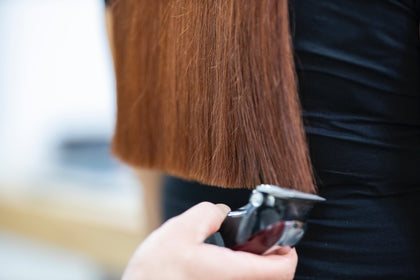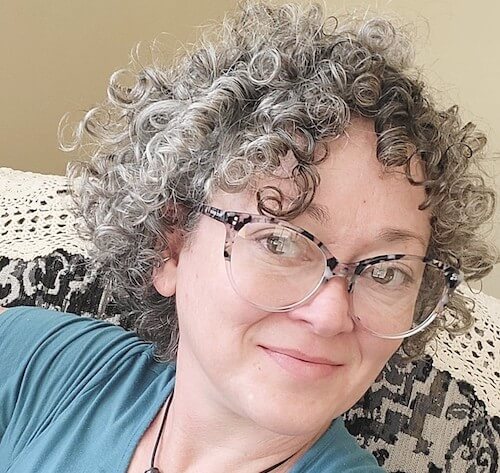What happens if you stop cutting your hair? Does it just grow on and on, longer and longer, until you can sit on it? Does it simply stop growing at some point or start wearing off at the ends? The answers may surprise you.
VEGAMOUR asked the experts what happens if you just stop getting your hair cut. Plus, find out what products you should use to support thicker, fuller looking locks.
How Often Should You Really Cut Your Hair?
There's no magic number for how often you should get a hair trim. In fact, it has a lot to do with the type of hair you have. Most stylists recommend anywhere from six to eight weeks for trimming off the ends. You can opt to trim less than 1/4 inch regularly off the hair less frequently to allow the hair to grow longer, or you can cut 1/2 inch to an inch every month or so to maintain the current hairstyle.
Frequency of Haircuts Per Hair Length or Type
To narrow down how often you should be getting your hair cut depends, here are some guidelines to give you an idea.
- Short haircuts: Every four to six weeks
- Medium to longer hairstyles: Every six weeks to maintain length; quarterly if you're trying to gain length.
- Heavily layered or styled hair: Every six weeks
- Curly and coily hair: Every two to four months
- Colored and chemically treated hair: Every four to six weeks to maintain the length; eight weeks if you're trying to gain length.
Shop: GRO More Kit — Care for Your Hair from the Inside Out
Why Regular Trimming?
Regular trims are a part of maintaining the integrity of your hair. Trimming your hair helps to:
- Remove any split ends.
- Remove damaged ends that no longer have integrity or elasticity.
- Keep the shape of your haircut intact.
What If You Stop Cutting Your Hair?
You may think, "If I don't cut my hair, it can grow out longer." This might make sense until you try it and your hair ends up looking not only unruly or shapeless but also shorter over time. This is because the ends of the hair, when untrimmed and unkempt, can wear and become damaged or break off near the ends of the hair.
VEGAMOUR spoke with Emiliano Vitale, creative director at é Salon, about what happens when you stop cutting your hair. "If you don't cut your hair, it may appear to stop growing," said Vitale. This is because as the ends get older and split, those splits begin to travel up the hair and cause breakage. So those with long hair may feel like it stays the same length, due to the ends breaking at a similar point."
Not cutting your hair leads to more than split ends. You may experience "worn-out" looking hair that's frizzy and tangly at the ends. Your hair will appear to stay the same length for a long time, which is simply because the ends "wear off," due to styling, hot tools and wear and tear from leaning against your hair when you sleep or sit against a textured surface like the seat of your car.
"A simple trim can take off the split ends, stopping them from traveling up the hair and allowing the hair to appear to keep growing," said Vitale. Plus, getting regular trims will remove the worn hair at the ends, even if it has not yet begun to split.
Related: Do Split Ends Stop Hair Growth?
Why Do Some People Grow Such Long Hair?
The world record for the longest "locs" documented belongs to Asha Mandela of Clermont, Florida. In 2009, the Guinness Book of World Records documented her locs as having a stunning length of 18 feet 6.5 inches. In 2022, her well-maintained hair is now estimated to be over 110 feet.
Her extreme hair growth is likely due, at least in part, to genetics. Your genetics have a lot to do with the length your hair can actually grow.
Most people deal with split ends once the hair isn't cut regularly, which essentially wears on the ends of the hair and keeps it from getting longer. The hair splits, and the splits run up the shaft. Eventually, the hair can break off at these weakened spots if not cared for.
How long your hair can grow also has to do with your hair's health. Your internal health also plays a role in how quickly your hair grows and the overall health of your hair. Healthy hair can withstand more wear and tear because the internal and external hair structures are more durable.
Related: What Causes Split Ends?
Best Ways to Promote Longer Hair Growth
Even if your brain is screaming, "I don't want to cut my hair," you should view it as a necessary part of hair maintenance. Regular trims do not help hair grow any faster, but they can help prevent split ends from forming, which is critical. As previously stated, your hair growth rate is likely around 1/2 inch per month (or a little more or less based on genetics). If you want your hair to grow longer, regularly getting your hair trimmed is key. This is especially true for curls, as split ends can frazzle curls and make them look completely unruly and frizzy.
Don'ts When Trying to Grow Longer Hair
- Don't stop cutting or trimming the hair because split ends that form can affect the ends of the hair all the way up to midshaft.
- Don't "pick" at your split ends as this can make them even worse!
- Don't neglect the basic care of your hair.
Do's for Trying to Grow Longer Hair
- Do attend regularly scheduled hair appointments to get your hair trimmed. A haircut will remove fragile ends or dead ends on the oldest part of the hair and also help you maintain hair length.
- Do go ahead and call your stylist to get you in sooner if your hair starts splitting — even if it's not time for a trim or haircut.
- Prevent damaged hair by avoiding styling with heat tools.
- Use a detox serum for your scalp to wash away impurities and promote a healthy scalp biome which helps to encourage healthy hair.
- Use a gentle, nourishing shampoo and conditioner to keep the hair hydrated.
- Use a satin pillowcase. This is especially helpful if you have curls!
- Replace any hair implements with broken bristles, and gently comb and brush your hair.
- Healthy hair will grow faster in the long run. Encourage your hair health and growth by eating a healthy diet and taking supplements full of hair-healthy vitamins and minerals.
- Avoid dry hair by occasionally treating it with an overnight mask.
- Act fast when you lose hair density due to excess hair loss. Start using a plant-based hair serum to encourage thicker, fuller looking hair.
Healthy Hair Takes an Effort
Healthy hair needs nourishment from the inside, care from the outside and regular hair trimming to stay shaped and uniform in length. VEGAMOUR makes this easier by providing vegan hair shampoos, conditioners, supplements, foams and serums for the care your hair needs to be stronger and longer!
#include-related-slider#
More From VEGAMOUR
- SHOP NEW: VEGAMOUR Hair Oil
- Is Sodium Laureth Sulfate Bad for Hair?
- Dry Haircut vs. Wet Haircut — Which Is Best for Your Hair Type?
- Read This Before Getting a "Big Chop"
Photo credit: Engin Akyurt/UnSplash
Back



















